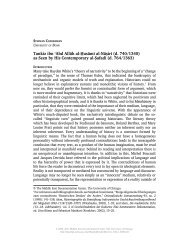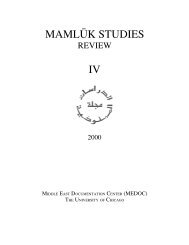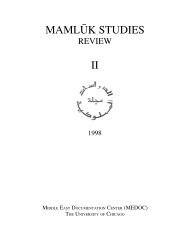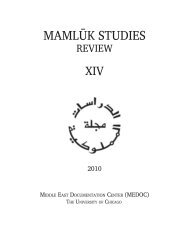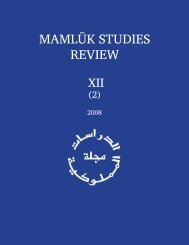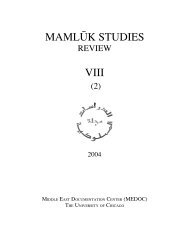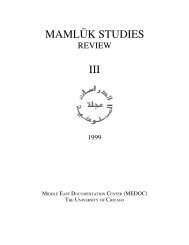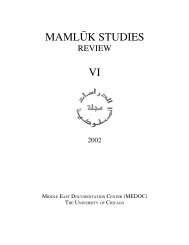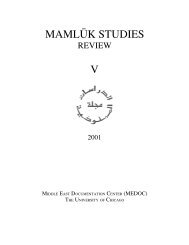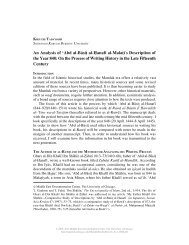Vol. VII, no. 1 (2003) - Mamluk Studies Review - University of Chicago
Vol. VII, no. 1 (2003) - Mamluk Studies Review - University of Chicago
Vol. VII, no. 1 (2003) - Mamluk Studies Review - University of Chicago
Create successful ePaper yourself
Turn your PDF publications into a flip-book with our unique Google optimized e-Paper software.
MAMLU±K STUDIES REVIEW VOL. 7, <strong>2003</strong> 13<br />
bad|‘ poetry himself. He also collected jokes, and his decidedly miscellaneous<br />
writings include a risa≠lah on the burning <strong>of</strong> Cairo by Barqu≠q in 791/1389, as well<br />
as poetry in praise <strong>of</strong> chess and horses. 37 Ibn H˛ijjah's friend, al-Nawa≠j|, was<br />
unkind e<strong>no</strong>ugh to write a study <strong>of</strong> his plagiarisms.<br />
Muh˝ammad ibn H˛asan Shams al-D|n al-Nawa≠j| (788–859/1386–1455) studied<br />
under al-Dam|r| (on whom see below), taught hadith at a couple <strong>of</strong> madrasahs and<br />
had Sufi links, but he is best k<strong>no</strong>wn for his anthology devoted to wine, H˛albat<br />
al-Kumayt (The Racecourse <strong>of</strong> the bay). Kumayt refers both to a dark bay horse<br />
and to a reddish brown wine, cups <strong>of</strong> which, in al-Nawa≠j|'s metaphor, circulated<br />
round the convivial table like race horses. Besides celebrating the joys <strong>of</strong> wine,<br />
al-Nawa≠j|'s anthology also devoted a lot <strong>of</strong> space to the ambient pleasures, such<br />
as gardens, furniture, flowers, candles, and lamps that went best with an amiable<br />
drinking session. Al-Nawa≠j|'s Kita≠b al-S˝abu≠h˝ was devoted to the more specialized<br />
pleasure <strong>of</strong> drinking in the morning. Both works followed the conventions <strong>of</strong> an<br />
extensive earlier literature <strong>of</strong> khamr|yah (works devoted to wine), and it is unclear<br />
whether al-Nawa≠j|'s work reflected a genuine enthusiasm for alcohol or whether it<br />
was just a<strong>no</strong>ther example <strong>of</strong> the literary antiquarianism that was so pervasive in<br />
the <strong>Mamluk</strong> period. The same question applies to his anthology devoted to beautiful<br />
boys, Mara≠ti‘ al-Ghazla≠n (The Prairie <strong>of</strong> gazelles), which also included some <strong>of</strong><br />
his own poems on the subject. Al-Nawa≠j| also compiled the ‘Uqu≠d al-La’a≠l,<br />
strings <strong>of</strong> pearls, a muwashshah˝ anthology, that drew heavily on Ibn Sana≠’ al-Mulk<br />
and al-S˛afad|. 38<br />
Much <strong>of</strong> <strong>Mamluk</strong> poetry consists either <strong>of</strong> light-hearted verses d'occasion or<br />
<strong>of</strong> experiments with riddles, chro<strong>no</strong>grams, and similarly artful and taxing devices.<br />
These sorts <strong>of</strong> productions have <strong>no</strong>t survived well compared to the work <strong>of</strong> older<br />
poets—to, say, the more directly hedonistic poetry <strong>of</strong> an Abu≠ Nuwa≠s or to the<br />
warrior's rhetoric <strong>of</strong> an Abu≠ Fira≠s. It is hard to point to much that was distinctively<br />
original. Nevertheless, despite the general conservatism <strong>of</strong> <strong>Mamluk</strong> poetry (and<br />
the badi‘, or "original" poetry, was at least as conservative as anything else) there<br />
were some developments, including a growing readiness to experiment with folk<br />
genres, including the muwashshah˝, the zajal, and the mawwa≠l. Andalusian influence<br />
was a factor here. Panegyrics were generally to the Prophet and to the ulama<br />
rather than to the <strong>Mamluk</strong> elite. Panegyrics to members <strong>of</strong> the <strong>Mamluk</strong> elite,<br />
while <strong>no</strong>t unk<strong>no</strong>wn, were <strong>no</strong>t so very common. However, <strong>Mamluk</strong> taste may lie<br />
37 Clément Huart, A History <strong>of</strong> Arabic Literature (London, 1903), 324–25. See also Geert Jan van<br />
Gelder, "Poetry for Easy Listening: Insija≠m and Related Concepts in Ibn H˛ijjah's Khiza≠nat al-Adab"<br />
in this issue.<br />
38 Geert Jan van Gelder, "A Muslim Encomium on Wine: The Racecourse <strong>of</strong> the Bay (H˛albat<br />
al-Kumayt) by al-Nawa≠©| (d. 859/1455) as a Post-Classical Arabic Work," Arabica 42 (1995):<br />
222–34.<br />
© <strong>2003</strong>, 2012 Middle East Documentation Center, The <strong>University</strong> <strong>of</strong> <strong>Chicago</strong>.<br />
http://mamluk.uchicago.edu/<strong>Mamluk</strong><strong>Studies</strong><strong>Review</strong>_<strong>VII</strong>-1_<strong>2003</strong>.pdf



